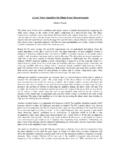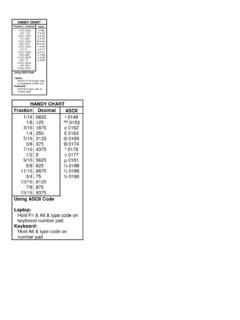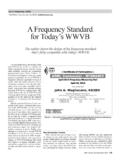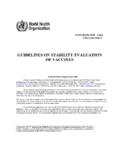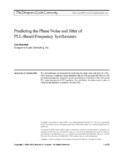Transcription of Unusual Frequency Dividers - techlib.com
1 1/2, k0 - 80 pF2 k2 k5 k0 - 5 V, 24 MHz6 MHz+ 5 VDCThe following circuit uses a 75140 line receiver to form an injection locked circuit is similar to the common op-amp square-wave oscillator with values selectedto keep the voltages within the recommended operating ranges. The Frequency to bedivided is coupled through a 5k resistor to the positive feedback input of the comparatorsuperimposing a volt squarewave. The small squarewave toggles the comparatorwhen the sawtooth voltage on the capacitor comes close to the DC level on the positivefeedback input. The result is that the comparator output Frequency is an integer sub-multiple of the input Frequency . Since the comparators exhibit good temperature stabilityand precision, the division ratio can be quite high.
2 A division factor over 20 is practicaland since the 75140 is a dual line receiver, two Dividers may be cascaded for divisionratios over 400. For ratios higher than 4, increase the 5k series resistor to 10k. Frequency divider made from injection locked Locked Frequency DividerThis paper is a collection of Unusual Frequency divider techniques which offer featuresnot achieved with ordinary divider ICs or Frequency DividersCharles WenzelThis type of divider usually exhibits poor phase noise performance but with propermodifications good phase noise performance may be achieved. The fundamentaltechnique is to use the output of the oscillator to gate the input pulses such that the inputpulse controls the output edges. For example, the output of the circuit shown could drivethe input of a D-type flip-flop with the input Frequency driving the flip-flop's clock on the D input has no effect on the output jitter.
3 3, 1N5711 CNCHC or AC inverters or gatesA pulse counter may be implemented by dumping the charge from a small capacitor intoa larger capacitor at the input Frequency . The voltage on the larger capacitor will increasein a staircase fashion. A comparator or other threshold device senses the voltageexceeding a certain level and a reset pulse discharges the capacitor. The followingschematic shows one implementation using a CMOS inverter IC and three Schottkydiodes. Each positive edge from the input inverter dumps charge from the small seriescapacitor, C, into the larger capacitor, NC, until the voltage reaches the gate the threshold is passed, the following three gates change state and the capacitor isdischarged through the feedback diode.
4 The use of three gates produces a slight delay togive a reliable reset pulse. The ratio of the capacitor values determines the division factorbut the optimum values will not necessarily be integer values. The input capacitor should be fairly small, perhaps 10 to 33 pf and the charge accumulating capacitor should be selected to give the desired division factor. A trimmer may be substituted for either capacitor to find the optimum operating Frequency DividerFinFin / N The optimum value is experimentally determined and is close to N x Frequency DividerGetting More Speed from a Logic FamilyHere is a simple trick for dividing a Frequency well above the toggle Frequency of aparticular logic family. The clock inputs of a logic family respond to frequencies well above the Frequency that the devices can successfully divide.
5 The output becomes a chaoticjumble of unpredictable sub-harmonics below the expected Frequency due to the internalcircuitry's inability to keep up with the fast clock. By adding a delay line to the commonD flip-flop divide-by-two circuit, the internal Frequency of the device can be lowered toan acceptable range. After one of the high Frequency pulses triggers the flip-flop allfollowing input pulses are ignored until the effect of the trigger propagates through theflip-flop and the delay line back to the D input (see the schematic below). The flip-flopwill trigger predictably if this delay is longer than the amount of time required for theflip-flop's internal circuitry to settle and the edge is not close to an input edge.
6 Obviously,the circuit must divide by more than two but a flip-flop capable of only dividing 50 MHz(by two) may be able to divide frequencies well above 100 MHz (by four or more).The circuit is Frequency specific due to the fixed delay but the technique can allow lowpower, slow devices to prescale surprisingly high fixed DCDQQCP++Fout Fin1/2, 74HC74LC(100 MHz)(10 MHz)( uH)(~40 pF)Flip-flop handles frequencies well above the input schematic shows the values to convert a 74HC74 into a divide-by-ten 100 MHzprescaler handling frequencies about three times higher than the specified maximuminput Frequency (30 MHz). The current consumption is only about 10 mA. The circuitmay be adjusted to work with frequencies approaching 150 MHz but the performancebecomes unreliable and temperature sensitive.
7 An experimental circuit was constructedwith a 74F74 which has a toggle Frequency near 100 MHz. Using a uH inductor forL and a 20 pF trimmer, the circuit was able to divide 400 MHz by 8 to give a 50 MHzoutput. (The circuit was not particularly stable. A prescaler is probably best for handling frequencies above 300 MHz.) The circuit should work well with slower devices including 4000 series CMOS and the older 74L74s. Since the device is toggling at the output Frequency , the power consumption will be lower than an ordinary divider from the samefamily. Sinewave Converter for Logic DevicesA grounded-base stage may be used to convert the output of a logic device to a typical implementation is shown in the following schematic.
8 The resonant tank shownis for an unusually low Frequency but higher Frequency outputs are easily achieved byappropriate choice of resonant transformer. Frequency Divider+15 VDC+15 uFAL= 2506T60T60 TTransformer: 120 turns center-tapped, 6 turn secondary on apot-core withAL= kHz15 kHz220 k12 uF2N4401 Divide by MPulse SwallowerRate MultiplierFoFiFpFrNrFr = Nr Fo10kk is the numberof decades in the Rate = Fi - FrA pulse is removed fromFi for every Fr = Fp / MFo = Fp M = Fi - FrM= Fi -k10 Nr FoM= FiM + Nr10kExample: Divide by M = 2, N = 34, k = 2 = Fi2 + 34102Fo= Multiplier Block DiagramRemoving pulses from the input of afrequency divider at a rate proportional to its output via the rate multiplier yields fractional - n multipliers provide a programmed number of pulses per decade of clock pulses.
9 Forexample, the CD4527 is a 4-bit BCD rate multiplier which will provide 3 pulses for every10 clock pulses when the input is programmed with 3. The pulses are spread out as muchas practical over the allotted time to reduce jitter. The rate multiplier may be combinedwith an ordinary divider and "pulse swallower" to form a fractional-n divider as shown inthe following block D QQCLRQSETSET/MR /Fin+ Fin401391113810 MRCLRMRFout40136966771211101211103215 143215 143215 1412111013413413499 CASCASCASSTCLR INHSSTCLR INHSSTCLR INHSCLKCLKCLK452745274527 OUTOUTOUTINH OINH O4023 BCD 1031312415109313124 CLKCLK757109 FinFin45104510/CAROUT/CAROUTRRDWNDWN/CIP EPE/CIP4P1P4P1 The circuit implementation shown below will divide by to The frequencyinput is connected to the pins labled "Fin" and an inverted version of the input is appliedto "/Fin".
10 "MR" and "/MR" are the master reset inputs. Fractional-n Divider

